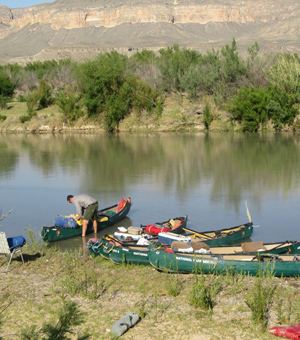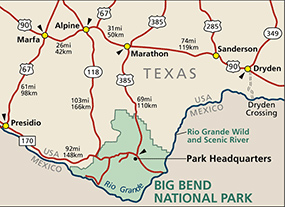Botany by Canoe
WHILE MANY BOTANISTS CHOOSE THEIR CAREERS for love of the outdoors, even the most hands-on of modern-day botany jobs usually don’t require much in the way of roughing it. Wildflower Center senior botanist and director Damon Waitt, Ph.D., says the opposite was true of a May river exhibition by canoe he and colleagues took to the Rio Grande Wild and Scenic River for the purpose of surveying plants there for the National Park System.

Canoes on the bank of the Rio Grande. PHOTO Damon Waitt
“Of our excursions, this by far put us in the most remote location,” says Waitt, who spent one cold night with his arm extended outside of his tent to keep it from hitting him in the face beneath the pressure of gusty winds. “We were five to eight hours away from rescue. We had to bring in everything that we needed – if it was forgotten, there was no way to get it,” says Waitt.
This is the fourth time that the National Park Service (NPS) has relied upon the Wildflower Center’s botanical expertise to observe, identify and survey plants within its park system. Over the past two years, Center botanists have traveled to Padre Island National Seashore, Big Bend National Park and Lake Amistad Recreation Area under the auspices of the NPS Inventory & Monitoring Program.
The information they compile from their travels helps NPS land managers monitor park ecosystems to better understand their dynamic nature and integrate the vegetation inventories into their planning, management, and decision-making. Knowing where native plants or a rare plant community occur or where there are large infestations of invasive plants can inform land management decisions. NPS plans to conduct vegetation surveys at more than 270 parks with significant natural resources within its system.
Waitt set out for the Rio Grande with the Center’s plant conservation team (Dr. Karen Clary, Minnette Marr and Jessica Strickland) along with site manager Philip Schulze and nursery manager Sean Watson. The journey began in Big Bend National Park where Clary and Marr could access the river by road. Despite being stranded one night in their vehicle due to flash flooding, the in-park survey went off without a hitch.
The bulk of the survey was done by canoe, with the Center staff multitasking as botanists, navigators, paddlers, and cooks. Also along were Patty Manning of Sul Ross University who lent strong West Texas botany expertise, river guide Jack Lowery, who brought his wild river savvy, and NPS River Ranger Doug Hens, who added security.
The group canoed about 10-12 miles a day, 72 miles total over seven days. “It’s one thing to be good at identifying plants,” says Waitt. “It’s another thing to be good at canoeing.”
They prepared in advance a list of plants they expected to see along the route. Sean Watson says that there were a few surprises – the biggest of which was finding Texas pistache (Pistacia mexicana). “You don’t find those in nature very often in Texas so this was cool to see even though it was on the Mexican side of the river. In San Francisco canyon, we also encountered the largest mountain laurel I have ever seen, with a trunk that measured about 40 inches in circumference.”
They saw a lot of canyon grape (Vitis arizonica) and annual native tobacco (Nicotiana repanda) and a beautiful yellow rock nettle (Eucnide bartoniodes) as well as a showy bicolor mustard (Nerisyrenia camporum) that was present on many of the survey plots. Watson says they started seeing the grape at about the same time they began encountering Berlandier ash (Fraxinus berlandieriana) — a tree in the olive family that grows to about 30 feet.

Map of South Texas showing the location of Rio Grande Wild and Scenic River. Image courtesy of NPS.gov
The crew paid particular attention to seeps and hanging gardens because they are rare and the plant communities differ from those on riverbanks.
Most surprising was how pervasive the invasive species were. Jessica Strickland says, “We knew that there would be giant cane, tree tobacco and Bermuda grass, but the extent of them was overwhelming.” The team was glad to know NPS personnel and volunteers were attempting to control giant cane at the same time they were on the river.
Just as these botanists’ expertise is an asset to NPS, so are these field-based opportunities to the Wildflower Center. “In addition to supporting our conservation programs, these opportunities allow our plant botanists and horticulturists to enhance their skills in the field while familiarizing themselves with these plants,” says Waitt. “We can return to these areas to collect seed for our conservation programs, and the exposure helps build our reputation as a scientific organization. The quality of our work is such that we are being sought out directly by NPS when a need arises.”
A few trips are planned for the coming year including an upcoming return trip to Padre Island National Seashore to survey plants not surveyed when wildfires interrupted a trip last summer and an expedition to Guadalupe Mountains National Park. Word is that trip will be by burro.

